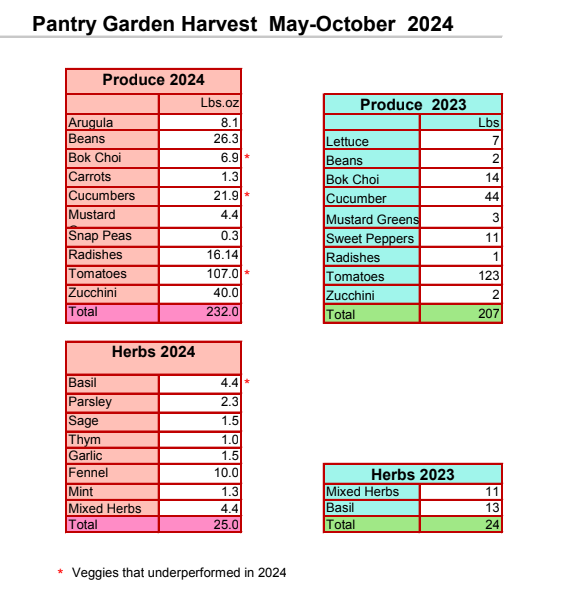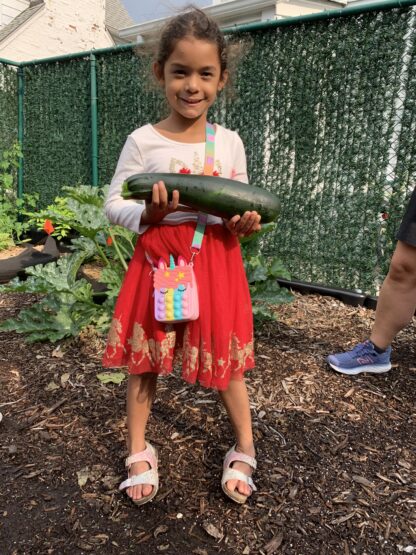Common Grounds – Celebrating Commonpoint’s 2024 Harvest

When October rolls in and Sukkot graces our backyards or balconies, Commonpoint’s Pantry Garden takes a well-deserved break. The time has come to treat the soil with enriching cover crops of clover, rye, and peas, which will boost the biome and prepare it for next spring.
Rough Beginnings, Great Finish.
I also do the numbers to see how well our garden yielded through the season and how many pounds of vegetables we distributed to the Pantry’s clients.
The season didn’t start well. The dry and hot spring killed at least 2/3 of my first seedlings. Additionally, NYC composting programs were put on pause, making it difficult for many community gardens that depend upon soil for enrichment. Last season, I was able to obtain 2000 lbs of free compost from the Queens Botanical Garden and Big Reuse. This year, both programs closed, as did most similar programs in the City, resulting in a city-wide shortage of the precious “black gold.” And yet, despite the compost crisis, this year our Pantry Garden production increased by 12%.

If it sounds like magic, well, it is not. The credit for those unlikely results goes to a new team of individuals, staff, volunteers, and school-aged children, who dedicated several hours a week to till, plant, water, propagate, weed, harvest, and distribute throughout the season. And let’s not forget our supporting host of invertebrates, from butterflies to earthworms.
Don’t get me wrong. The soil still needs compost for our garden to thrive. Eliminating scrap collection sites and, consequently, compost production and give-away, caused such a stir through the NYC gardening community, and fortunately, we are now seeing a slow return of the composting programs. The more compost we feed our soil, the more produce it will yield, and the more Pantry clients will benefit from our garden.
Beanstalk vs Pumpkins
Obviously, a beanstalk will help you reach the giants in the sky while a pumpkin will turn into a golden carriage and whisk you to a princely ball. Your choice. You do you.
But there is more to the story.
For the most part, this year, we grew the same vegetables as last year. Practical considerations guide our choice of edibles to grow: space availability, growth pattern, resilience to diseases, and ease of distribution stand at the heart of all the decisions we make.
To compensate for a limited real estate, a gardener will opt for plants that grow vertically on stakes or trellis: hence our tomatoes, cucumbers, and pole beans. Similarly, many herbs such as Parsley, Sage, Rosemary, and Thyme, do very well in a pot—which I leaned at the Scarborough Fair. (Oops, I just aged my-self…)
Also to compensate for a limited space, we chose plants with indeterminate growth pattern. Often clients or neighbors ask us why we don’t grow those beefy New Jersey Beefsteak tomatoes. We would love to, but they are determinate. All their fruit ripen within a week, and once harvested, the plant dies. The list of determinate edibles also includes root veggies such as carrots, beets, and potatoes. Our space is too precious to populate it with single-harvest varieties. Instead, our choice of indeterminate produce and herbs ensures that what we plant in the spring will yield continuous harvests throughout the season.
Plant diseases weigh a great deal in our choice of veggie varieties. After a Powdery Mildew infection decimated all of last year’s beans, this year, we were not going to replace them with space consuming squash or eggplants. Our garden being organic, the application of an aggressive fungicide would not do either. Fortunately, a bean is not just a bean. Pole “green beans” come in many varieties, including a few that are immune to Powdery Mildew. This summer, you may have caught a glimpse of the four superb Powdery Mildew resistant beanstalks draped over half our trellis. They yielded 40 lbs of beans. They also housed Jack, our resident praying mantis.


Lastly, we must consider the ease of distribution. A pumpkin would be fun to grow. But a single pumpkin would occupy more space than is available in most of our beds. It would also require cutting and wrapping, which we cannot accomplish according to food safety regulations. In contrast, herbs, cherry and grape tomatoes, beans, and cucumbers allow for clean and easy portioning and distribution.
The chart above shows a huge increase in Zucchini production this year. The Zucchini were sown in the spring by the Nursery children in the Commonpoint Early Childhood program for 3 and 4 year olds. To add a Native cultural flavor to their garden, they also sowed Corn and Beans. As the “Three Sisters” matured through the summer, the Zucchini exceeded all expectations: most of them weighed one pound and a half, but some reached an eye-popping two pounds! But as educational and satisfying those giants were to the children and the gardeners, we could never distribute more than two or three at a time to Pantry clients on any given day. The Nursery children will continue to grow Zucchini, maybe even a pumpkin or two in their garden for the joy and educational value those massive veggies bring to the Enrichment program. But they are unlikely candidates for our Pantry Garden.

So, Now What?
Now that the numbers are in and the garden put to bed, you may think that the gardeners will go back home and hibernate until the spring. Not quite so. As mentioned earlier when fall comes, gardeners pamper the soil and winterize it in preparation for the next spring. In addition, this year, we have decided to experiment with cold season crops. Yes, we are unstoppable. A gardener will garden. No matter what. At least until the soil freezes.
We have already sowed watermelon radishes, mustard green, and arugula. Then in November, I will ask the Nursery children to plant garlic cloves. The Fall is also the time when gardeners wash all their tools (yes, we used soap and water, and even alcohol) sharpen anything that cuts and sand anything that may have rusted. When winter comes, we plan for the following year and lovingly revisit our seed collection. We also dive with delight into plant catalogs or website. We daydream of next year’s harvest—and healthy beanstalks reaching for the sky.
If you have any questions about your own garden, or how to get involved in our gardening program in Forest Hills, please contact MarieH at MZanzal@commonpoint.org




